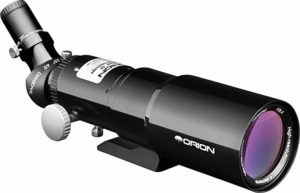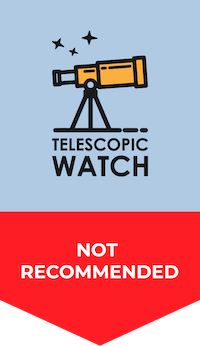Optics

The StarBlast 62 optically is a 62mm f/8.4 Petzval apochromatic refractor with a 520mm focal length. These scopes are made by Long Perng Optical, who are renowned for their quality refractors. Petzvals are relatively uncommon today due to the availability of aftermarket field flatteners and relatively cheap ED glass, making them rather irrelevant, but they are still nice scopes. The Petzval design uses a long-focus achromatic (non-ED) objective lens in conjunction with a focal reducer/field flattener. The result is that the StarBlast 62 has very little chromatic aberration and basically no field curvature, making it extremely sharp at both low and high magnifications as well as being suitable for astrophotography. However, it is still inferior to a real ED doublet refractor with a separate field flattener coupled to the scope.
Mechanics
The scope’s dew shield is retractable to fit the scope in its case. Unfortunately, the lens cell is not collimatable as a Petzval should be, which is a bit disconcerting.
The focuser on the StarBlast 62 is a rotatable, single-speed, 1.25” Crayford. While a dual-speed would be preferable, this focuser is certainly more than adequate for visual astronomy. While there’s no finderscope or bracket for one on the StarBlast 62, the focuser has two threaded holes where you could attach a standard finder shoe. The StarBlast 62 has a permanently attached Vixen dovetail plate, which will allow you to attach it to any compatible mounts, and the plate has a threaded ¼ 20 hole for using the scope on a photo tripod.
Accessories
The StarBlast 62 comes with two Long Perng “Sterling” Plossl eyepieces, with 20mm and 4mm focal lengths, providing 26x and 130x, respectively. The Sterling Plossls are spectacular for the price and easily go head-to-head with my Tele-Vue Plossls in sharpness. However, the 4mm has such a small eye lens and such short eye relief that it is nearly impossible to look through. To get the most out of the scope, you’ll definitely want other eyepieces.
The StarBlast 62 comes with a high-quality 45-degree erecting prism diagonal. While it works very well, for astronomical use, a true 1.25” 90-degree star diagonal will prove to be more comfortable and provide better images.
The StarBlast 62’s aluminum and the foam-lined case are of high quality, and they do a good job protecting the scope and any accessories. However, it’s not the most volume-efficient option—if you’re planning on flying with the scope, putting the tube in a smaller case and transporting the accessories separately is probably a better option.
Mount Recommendations
For visual observation, the Starblast 62mm works well on a lightweight alt-azimuth mount like the Explore Scientific Twilight I or Twilight Nano, Orion VersaGo, or Sky-Watcher AZ-GTi, along with many good photo tripods. Astrophotography requires a GoTo equatorial mount with tracking such as the Sky-Watcher EQM-35i or, preferably, a more robust unit such as the HEQ5i or similar mounts.
Should I buy a Used Orion StarBlast 62mm?
When looking to purchase a second-hand StarBlast 62mm, it is unlikely that there will be any major issues. Anything that may be wrong with the scope, such as damage to the objective lens or focuser, will be easily noticeable, and the Petzval internal optics are fairly robust. A used unit may also come with addons such as a proper star diagonal or tube rings, which the stock telescope lacks.
Aftermarket Accessory Recommendations
Replacing the StarBlast 62’s mediocre and uncomfortable 45-degree erecting prism with a higher-quality prism or mirror star diagonal is recommended for astronomical observing. The Celestron 94115-A Prism 1.25″ diagonal is an affordable choice, while the Apertura 1.25″ dielectric mirror diagonal is also great. Both of these options can significantly improve image brightness and sharpness, as well as make it easier to aim at objects in the sky.
The 20mm Plossl eyepiece provided with the StarBlast 62 is very high quality, but it is not optimized for maxing out its attainable true field of view. A 1.25″ 32mm Plossl eyepiece (16x) would be ideal for deep-sky viewing since its 52-degree apparent field at 16x translates to a huge true field of 3.25 degrees (6.5x the diameter of the full Moon). It’s also a good idea to have at least one other high-power eyepiece other than the nearly-unusable 4mm Plossl, such as a 9mm and 6mm redline/goldline (58x and 87x respectively). Using over 100x with the StarBlast 62 is not advised due to the dim and hard-to-focus image you will get at such high power with a small scope. A UHC nebula filter such as the Orion UltraBlock 1.25” improves views of nebulae with the StarBlast 62, and you may also want some sort of red dot finder to help you aim it around the sky.
Astrophotography Capabilities
Due to its 1.25” focuser, the StarBlast 62, unfortunately, will not work with some astro-imaging cameras or full-frame DSLRs due to the vignetting that will result. However, it comes with a T-adapter to use with a DSLR and many smaller-chip cameras should have no issues with the scope.
While there are more effective astrophotography scopes in its price range with better focusers and/or more aperture, the StarBlast 62 is no slouch for a beginner astrophotographer. The scope’s Petzval design and resulting flat field mean sharp images across the entire frame. However, the lack of dual-speed focusing nor a 2” drawtube will limit you later on, as will the lack of an easy method to attach tube rings or a guide scope. The scope was simply not designed with serious long-exposure astrophotography in mind.
Such a small and relatively unoptimized scope like the StarBlast 62 has little place for planetary imaging. A 6-8” or larger telescope is best for the job.
What can you see?
The StarBlast 62’s small aperture is quite limiting when it comes to viewing. You can see plenty of lunar detail, the cloud belts and moons of Jupiter and Saturn, the phases of Mercury and Venus, and maybe some detail on Mars if you’re lucky. Uranus and Neptune are difficult to pick out from the stars, and their moons are of course invisible with such a small aperture. Deep-sky objects, even the brightest ones, are going to be a letdown; with the exception of open star clusters and large emission nebulae (the latter requiring dark skies and a good UHC filter), there isn’t a lot to see; galaxies, planetary nebulae, and globular clusters are little more than unresolved smudges if you can see them at all, while the 520mm focal length and lack of a 2” focuser greatly constrain the field of view. The StarBlast 62 is not a serious observer’s scope—it’s the kind of thing you stargaze with for 20 minutes before packing up or moving on to something bigger.



Thanks. I’d like to know what you would recommend instead. I want a scope good for birds, nature, and the moon and planets, with easy setup and use. Please let me know.
A small Maksutov-Cassegrain like the Sky-Watcher Virtuoso or Celestron C90 would be ideal